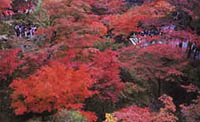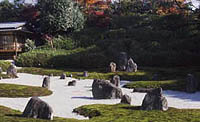| |
|
|
|
|
| |
 |
All exhibitions of the Nippon Suiseki Association are supported by the
Japanese Agency for Cultural Affairs and the Tokyo Metropolitan Government. |
|
|
|
|
|
|
| |
|
|
| |
|
|
| |
|
|
| |
 |
|
| |
Answering this relatively simple question is actually quite a difficult
task. Suiseki is not merely the hobby of looking at stones in a particular
way, but is rather a complex and multi-faceted Japanese tradition whose
understanding requires consideration from a number of different angles.
For a brief look at how to consider stones in the terms of suiseki, please
see the “Factors” section. |
|
 |
| |
 |
|
| |
As mentioned in the Introduction, suiseki
in Japan is thought to have started in the Muromachi period, particularly in
the Nanbokucho era (1336-1392).
Originally brought from China, suiseki, as with a number of other
cultural traditions, underwent a series of changes before assuming its current
Japanese form. Zen Buddhism and tea,
both brought from the continent somewhat earlier, along with the native
aristocratic Higashi-yama culture, all contributed to the shaping and
development of suiseki.
One way in which the tradition changed after coming to Japan can be seen in the general tendency that here darker subdued colors, particularly a deep black, are considered ideal, whereas in the Chinese tradition more showy stones are common and highly prized. Also, the formal way of displaying a single suiseki, in a tokonoma for example, is a Japanese development, while multiple stones are often displayed together in China.
Like Noh theater and the tea ceremony, suiseki is an old tradition with a long history. Emperor Godaigo (1288-1339) was an avid enthusiast and the former owner of the Tokugawa Museum’s Yume-no-Ukihashi, and associations like this lend the tradition a certain elegance, which we are proud to continue today.
|
|
 |
| |
 |
|
| |
We would like to recommend a book by Yasunari Kawabata: “Japan, the Beautiful, and Myself.” This book is useful not only in furthering the understanding of Japanese culture, but also of suiseki. It reads:
The Japanese Garden too, of course, symbolizes the vastness of nature. (…) Nothing is more complicated, varied, attentive to detail than the Japanese art of landscape gardening. Thus there is the form called the dry landscape, composed entirely of rocks, in which the arrangement of the rocks gives expression to mountains and rivers that are not present, and even suggests the waves of the great ocean breaking in upon the cliffs. Compressed to the ultimate, the Japanese garden becomes the bonsai dwarf garden, or the bonseki, its dry version.
The Oriental word for landscape, literally “mountain-water,” with its related implications in landscape painting and landscape gardening, there is contained the concept of the sere and wasted, and even of the sad and threadbare. Yet in the sad, austere, autumnal qualities so valued by the tea ceremony, itself summarized by the expression “gently respectful, cleanly quiet,” there lies concealed a great richness of spirit; and the tea room, so rigidly confined and simple, contains boundless space and unlimited elegance. (Translated by Edward G. Seidensticker)
|
|
| |
 Red leaves in Kyoto
Red leaves in Kyoto
|
 Zen temple in Kyoto
Zen temple in Kyoto
|
"The hagi
falls,the autumn wind is piercing Upon the
wall,the evening sun disappears."
(Poem by Empress Eifuku) |
|
|
| |
|
|
|
| |
|
|
|
Copyright
(C) Nippon Suiseki Association. All Rights Reserved.
|
|